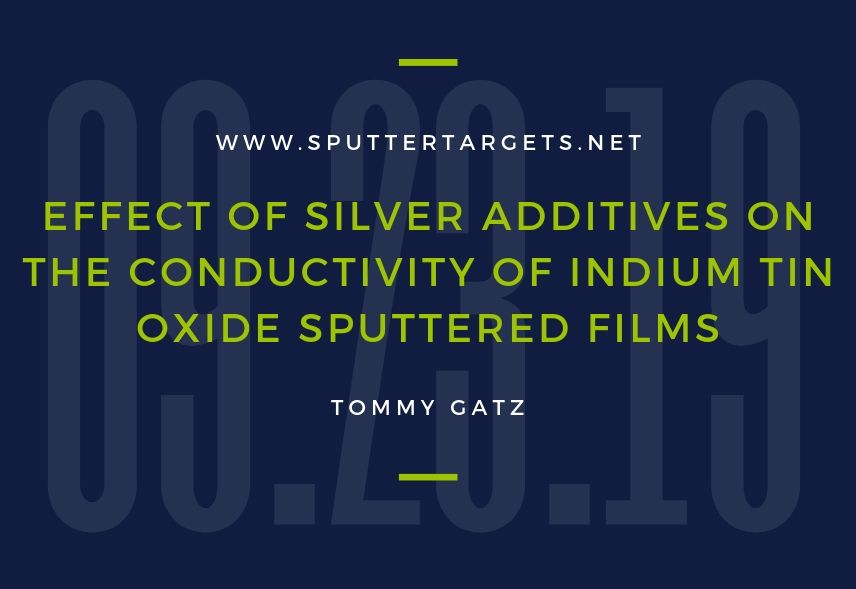Transparent conductive films have many applications, and indium tin oxide films have received great attention in the glass manufacturing industry due to their excellent properties. However, the manufacturing process of the indium tin oxide film requires a higher temperature, which limits its application. In order to reduce this temperature, various “sintering agents” have been taken into consideration. Recently, silver additives have received increasing attention. Its effect on the ITO film is two-fold. A small addition can actually reduce the processing temperature, but it also increases the luminous absorptance of the film.
Silver can be used as an additive for indium tin oxide sputtering coating because silver target sputters are much faster than alloyed indium and tin. During the experiment (20 min), the silver sputtering target is covered by a shutter. The shutter was opened on only occasions during the 20 min for approximately 2 s each time. Because the silver sputter target demands other working conditions than those of the alloy, the reactive plasma for the alloy target was shut down and a new plasma was lit for the silver target, using only argon and higher gas pressure. The substrate is obtained to obtain a uniform film. The specific experimental reaction conditions are as follows.
| Target tilt with respect to the horizontal plane | 35 |
| Target 1 material (purity, manufacturer) | Alloy of 90 at.% indium and 10 at.% tin (99.99%, Stanford Advanced Materials (SAM) Inc.) |
| Target 2 material (purity, manufacturer) | Silver (99.99%, SAM Inc.) |
| Target size | 5 cm in diameter, 0.6 cm thick |
| Sputter gases (purity) | Ar 99.998% and O2 99.998% |
| Sputter pressure for the alloy (silver) target | 5.3*10-3 mbar (8.0*10-3 mbar) |
| DC power for the alloy silver target | 55 W (70 W) |
| Sputter temperature and time | Room temperature and 20 min |
| Deposition rate | 44-65 A˚/min |
| Substrate | Corning 7059 glass |
The experiment was divided into five samples. One sample was not added with silver (0 mol%), and the other four samples were added with different doses of silver (1, 2, 6, 9 mol/%); each sample was divided into four parts, one part was left unaffected, and the Others were annealed at 100, 200 and 300 ° C in a reducing gas with composition of 7 vol.% H and 93 vol.% N2.
The experimental results show that the electrical resistivity is significantly reduced when the annealing temperature is 200 or 300 ° C, regardless of the silver content, without annealing or annealing temperature of 100 ° C. For samples treated at 200 and 300 ° C, the resistivity decreases with increasing silver content, the silver content is 6 mol%, the resistivity is minimized, and then increases with increasing silver. As shown in the following table:
| [Ag]/[In] (mol%) | Resistivity (mΩ cm) | |||
| – | 100℃ | 200℃ | 300℃ | |
| 0 | 20 | 70 | 6.8 | 2.8 |
| 1 | n.c. b | 2000 | 3.5 | 2.2 |
| 2 | 30 | 40 | 3.9 | 2.2 |
| 6 | 60 | 300 | 3.2 | 1.2 |
| 9 | 50 | 100 | 4.0 | 3.0 |
The conclusion we have obtained is as follows:
1. Use a small amount of silver additive to increase the conductivity of the ITO film by up to twice;
2. The highest conductivity is obtained in samples annealed at 300 °C due to the largest number of charge carriers.
3. When the content of silver additive is higher than 6 mol%, the electrical conductivity of the ITO film decreases. We believe that this is due to an increase in the number of grain boundaries, which leads to a decrease in carrier mobility.
This work has been financially supported by Stanford Advanced Materials Inc. For more information, please visit https://www.sputtertargets.net/.




